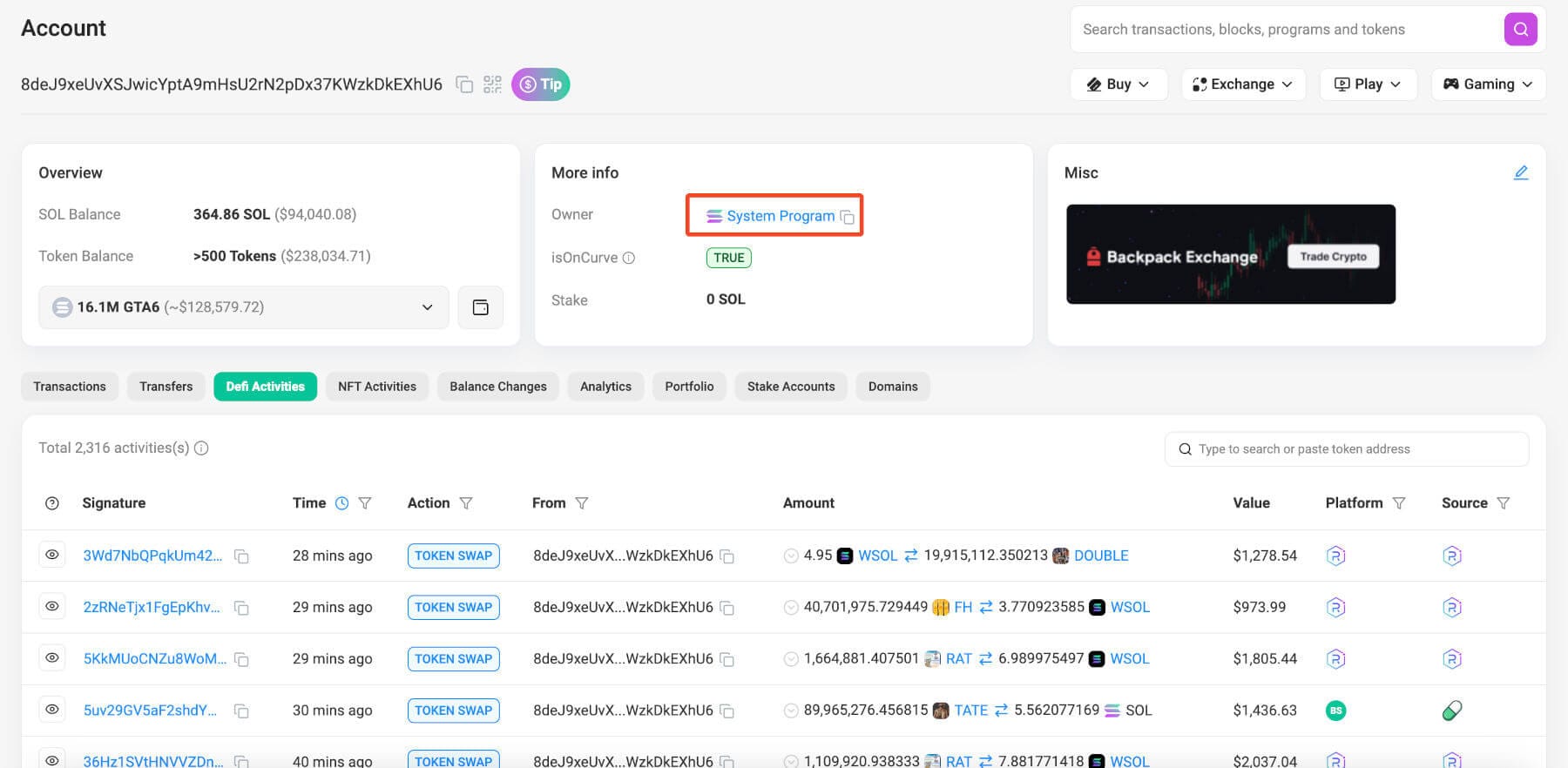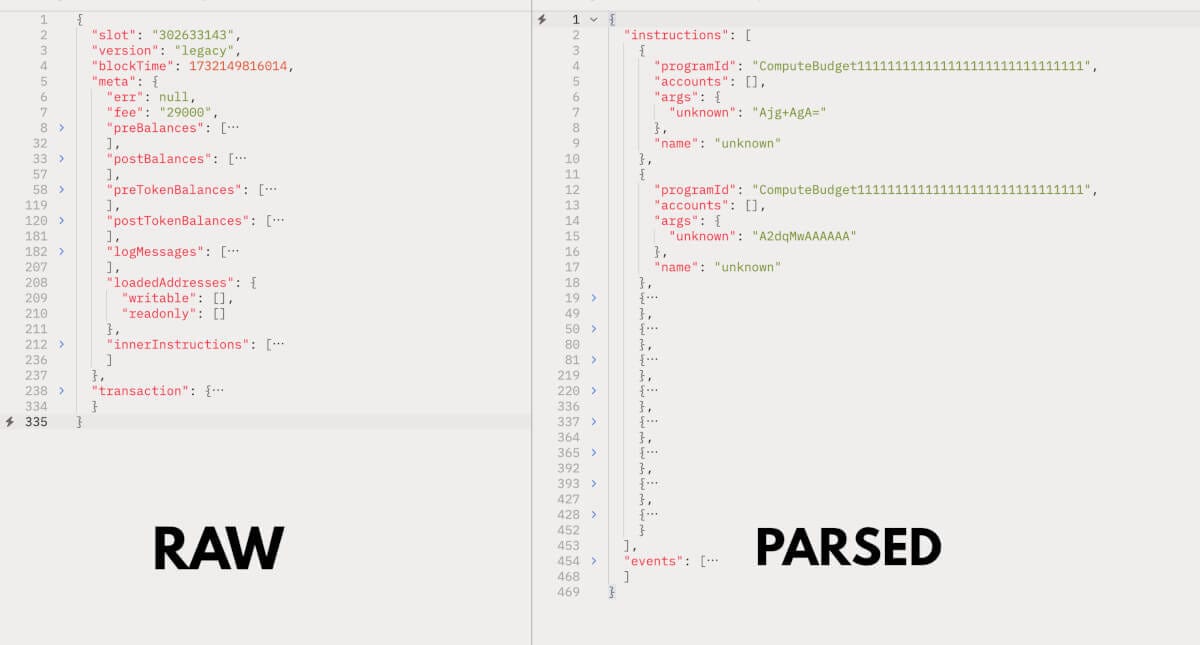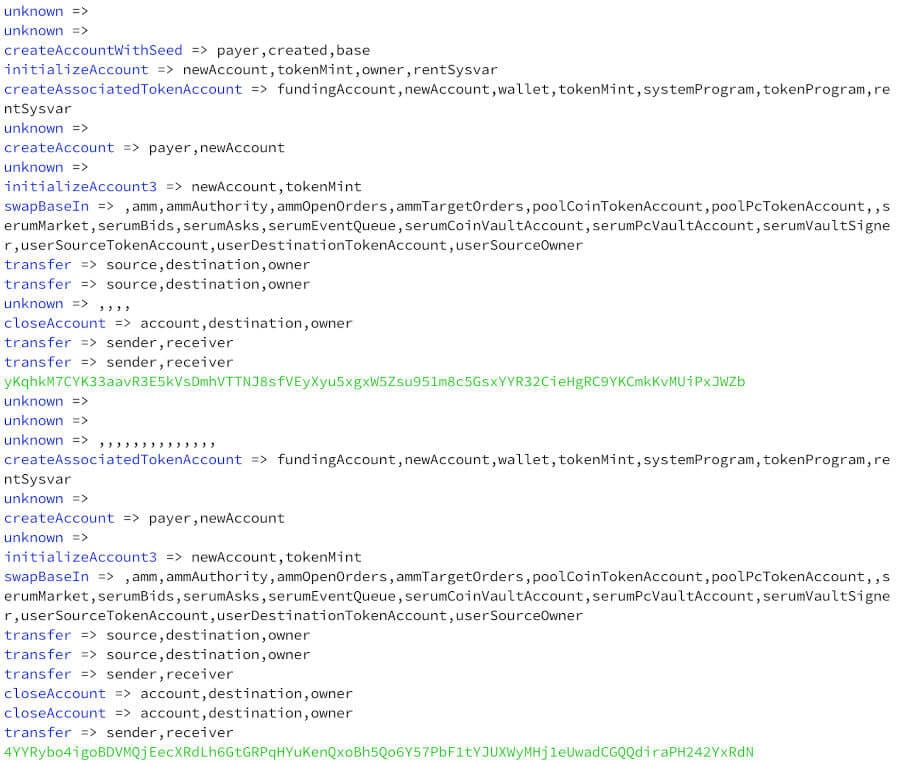Understanding Solana Instructions - Lightning Round
Welcome to my notes! Solana's been giving me a hard time with its instructions and how nothing is straightforward and humanly readable.
Even using Shyft's replit codes in parsing the instructions is not sufficient. So I'm writing my findings and notes here in case anyone finds it useful.
For background, I'm a Web2 developer, first time exploring Solana blockchain.
Basics of Solana Blockchain
Quicknode provides a very good introduction to the whole data architecture, hope I found it earlier.
- The main thing about the Solana blockchain is that everything is an account. There are 3 types of accounts
- Data accounts - holds data, like your tokens
- Program accounts - like a smart contract, can execute stuff
- Native System accounts - like the main Solana program where your wallets are created
- Your wallet's a data account. If you bought some Solana coins, your wallet will have Token Accounts for each of these coins. The Token Account is inherited from the SPL program, something like this.
- You are paying 0.002 SOL for 2 years worth of rent in the validator's space for each of these accounts. Yes, that means if you're not holding any coins anymore, you can get your 0.002 SOL back using SOL incinerator. And if you close the token account with the coins in it, all coins will be gone!
- Every transaction contain instructions, if one of the instructions fail, the whole transaction fails and all instructions won't be executed. The instructions contain the specific tasks that the transaction will do on the blockchain so this part is the gibberish part for me.
- The main Solana program is called a System Program, you'll find this with a regular main user wallet when you check Solscan.

Streaming gRPC Transactions from Raydium's Pools
At first I didn't know what was going on, I spent hours reading these transactions and comparing them with each other.
So listening to Raydium's Pools will get you the swaps made in the pools, and when a pool is created.
Below shows the difference between the raw transaction and a parsed one.
The left one is the raw transaction. and after parsing using Shyft's replit codes, I was hoping to get the "Swap 4.95 ($1,273.68) WSOL for 19,915,112.350213 ($237.1) DOUBLE" part of Solscan, but you will only get the instructions, step by step.

That means, you would need to get the token's details like name, description and socials, using another method, through an RPC.
Overview of Swap Instructions
The instructions come in an array, so I'm curious what kind of instructions we get.
I loop through each of the instructions and log the names. Most of the transactions look like these, with the green as the signature and the blue text as the main instruction and if the instruction has an array of accounts, I loop through it.

Zooming in into one of the instructions with an array of accounts look like this:
{
"name": "createAccountWithSeed",
"accounts": [
{
"name": "payer",
"pubkey": "GSnawsSqqZb49ZLHgNVpxDq4YbtJ2kpB2Fs5vYfXrQV4",
"isSigner": true,
"isWritable": true
},
{
"name": "created",
"pubkey": "8EAbhnCE89yGwn2Fd544p3wBRKZ2pUw85LkHiXGAG57o",
"isSigner": false,
"isWritable": true
},
{
"name": "base",
"pubkey": "GSnawsSqqZb49ZLHgNVpxDq4YbtJ2kpB2Fs5vYfXrQV4",
"isSigner": true,
"isWritable": false
}
],
"args": {
"lamports": 2039280,
"owner": "TokenkegQfeZyiNwAJbNbGKPFXCWuBvf9Ss623VQ5DA",
"space": 165,
"seed": "1732150799048",
"base": "GSnawsSqqZb49ZLHgNVpxDq4YbtJ2kpB2Fs5vYfXrQV4"
},
"programId": "11111111111111111111111111111111"
}I figured later on that the important instruction for swapping would be the one with the swapBaseIn and swapBaseOut which includes the liquidity pool (name as amm) and the signer / wallet involved with isSigner: true.
The difference?
swapBaseIn:
- You specify exact amount you're putting in
- Output amount is variable (but has a minimum)
- Example: "I want to swap exactly 1 SOL, give me as many USDC as possible but at least X amount"
swapBaseOut:
- You specify exact amount you want to receive
- Input amount is variable (but has a maximum)
- Example: "I want to receive exactly 100 USDC, take as little SOL as needed but no more than X amount"
In the instruction arguments you'll see:
- swapBaseIn has:
amountInandminimumAmountOut - swapBaseOut has:
maxAmountInandexactAmountOut
pubkey contains the Solana account responsible for the instruction ~ user wallet, token wallet, solana program, etc.
A sample swapBaseIn instruction looks like this:
{
"name": "swapBaseIn",
"accounts": [
{
"isSigner": false,
"isWritable": false,
"pubkey": "TokenkegQfeZyiNwAJbNbGKPFXCWuBvf9Ss623VQ5DA"
},
{
"isSigner": false,
"isWritable": true,
"pubkey": "6JidxKSVqnyuBd4Py9N4WWCLVLXFo5cU6JAREbUoX9vN",
"name": "amm"
},
{
"isSigner": false,
"isWritable": false,
"pubkey": "5Q544fKrFoe6tsEbD7S8EmxGTJYAKtTVhAW5Q5pge4j1",
"name": "ammAuthority"
},
{
"isSigner": false,
"isWritable": true,
"pubkey": "AoP4f3y7AGGsApqwSRPAzkfJkkRCV8xhGKFPAxYNkUhw",
"name": "ammOpenOrders"
},
{
"isSigner": false,
"isWritable": true,
"pubkey": "C3Xkgp75b5QFqX9ENMmMn5Q8qo9RxtfJG4d5JrBBAn3z",
"name": "ammTargetOrders"
},
{
"isSigner": false,
"isWritable": true,
"pubkey": "5F2jMshsVTxPHt5tv2sCYJVfg36YVGZAxmvm6B2wMbr4",
"name": "poolCoinTokenAccount"
},
{
"isSigner": false,
"isWritable": true,
"pubkey": "1bjJ3Pwpex7DsevVWuBeKHWUoBmoMDEhvoTpSbG64k7",
"name": "poolPcTokenAccount"
},
{
"isSigner": false,
"isWritable": false,
"pubkey": "srmqPvymJeFKQ4zGQed1GFppgkRHL9kaELCbyksJtPX"
},
{
"isSigner": false,
"isWritable": true,
"pubkey": "AqCWq89SRDcVw5vUQcPTaiLdpGvftvgMCezw4qVeHrTw",
"name": "serumMarket"
},
{
"isSigner": false,
"isWritable": true,
"pubkey": "D5i3mqvbxLiCMReqNeXcKXs9CsWtuHbo4h2ihyiJmDjU",
"name": "serumBids"
},
{
"isSigner": false,
"isWritable": true,
"pubkey": "DT1Fk8FxVaKpy5HCJ7vyrFVsHHS7voE4VBNEUMcRCQnw",
"name": "serumAsks"
},
{
"isSigner": false,
"isWritable": true,
"pubkey": "4N7BwJdUZY2se2LfgDw54rcYDsdZtDfWkSLyB3QU2Yi7",
"name": "serumEventQueue"
},
{
"isSigner": false,
"isWritable": true,
"pubkey": "79r2kqh4WaDEEddR6KBw1SQGVtMah2mj7DR6Cv9Bbgef",
"name": "serumCoinVaultAccount"
},
{
"isSigner": false,
"isWritable": true,
"pubkey": "9iDmnTh3FGogfq5GUEdAWv2xNntygFCpu5rAxytZQ39z",
"name": "serumPcVaultAccount"
},
{
"isSigner": false,
"isWritable": false,
"pubkey": "5Q544fKrFoe6tsEbD7S8EmxGTJYAKtTVhAW5Q5pge4j1",
"name": "serumVaultSigner"
},
{
"isSigner": false,
"isWritable": true,
"pubkey": "AAc1FbGszgPyPMDpe9eCsnP8y4HfRXVLciXDMFR446mU",
"name": "userSourceTokenAccount"
},
{
"isSigner": false,
"isWritable": true,
"pubkey": "8EAbhnCE89yGwn2Fd544p3wBRKZ2pUw85LkHiXGAG57o",
"name": "userDestinationTokenAccount"
},
{
"isSigner": true,
"isWritable": true,
"pubkey": "GSnawsSqqZb49ZLHgNVpxDq4YbtJ2kpB2Fs5vYfXrQV4",
"name": "userSourceOwner"
}
],
"args": {
"amountIn": "13875836660",
"minimumAmountOut": "1"
},
"programId": "675kPX9MHTjS2zt1qfr1NYHuzeLXfQM9H24wFSUt1Mp8",
"parentProgramId": "6m2CDdhRgxpH4WjvdzxAYbGxwdGUz5MziiL5jek2kBma"
}And it looks like this in Solscan if you expand the instructions area:

By this point, I was able to understand 80% of what's happening. And this is just Raydium,
Pump fun's transactions is somewhat the same, but a bit different and simpler. It uses only 2 event names:
- CreateEvent - when a token is created
- TradeEvent - when a token is traded
This time it only took me about 2 hours to parse it, building on top of what I learned from reading Raydium's transactions.
Other Useful Resources
- Waiting for Pumpfun tokens to complete the bonding curve
- Tracking new pools created from Raydium
- Shyft's complete list of sample codes for grpc streaming
My notes end here, hope I was able to help you understand the instructions!